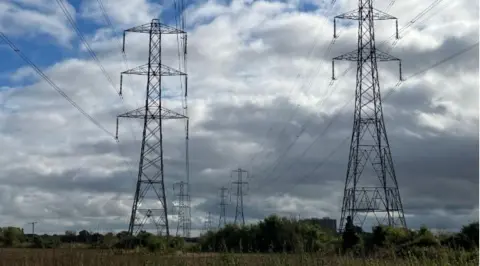**Pylons: The Cost-Effective Solution, According to New Report**
An independent report released by the Institution of Engineering and Technology (IET) has concluded that constructing overhead power lines using pylons remains the most economical option available for transmitting electricity, particularly amidst ongoing discussions about future energy projects in the UK. This crucial study emerges as the National Grid prepares to file planning applications for constructing over 100 miles (approximately 160 kilometers) of new pylons, stretching from Norwich in Norfolk to Tilbury in Essex.
Energy minister Michael Shanks has endorsed the findings, claiming that the report establishes pylons as “the best option for taxpayers.” The findings come at a significant time as the nation aims to enhance its electricity infrastructure to accommodate the anticipated surge in power demand from new offshore wind farms in the North Sea. Minister Shanks emphasized the urgency for such infrastructure, suggesting that overhead lines could ultimately be less burdensome for billpayers compared to alternatives.
However, the report has not gone unchallenged. Critics, including local campaigners, have lambasted the findings as “half-baked” and accused the government of being “blinkered” to the vital role pylons play in energy transmission. Opposition groups argue that the report fails to consider the potential benefits of alternative methods, such as burying cables underground or installing them underwater, which could minimize visual and environmental impacts.
The study’s economic assertions are stark: it revealed that the costs of underground cables are, on average, around four-and-a-half times higher than overhead lines, with seabed cables potentially costing as much as elevenfold. For instance, a typical nine-mile (15-km) overhead line, capable of transmitting 5,000 megawatts, is estimated at nearly £40 million. In contrast, the same electricity capacity transmitted via underground cable might require a staggering £330 million, potentially escalating to £820 million if tunneling is necessary.
**Visual Impact Considerations**
As stakeholders grapple with the logistics behind energy infrastructure, the IET’s report has also flagged important considerations beyond fiscal implications, including the “visual impact” of pylons versus underground solutions. David Reid, a co-author of the report, noted the document provides critical insights into available technologies and their respective advantages. He suggested that this information would be invaluable in guiding stakeholders involved in the necessary structural developments aimed at achieving the UK’s net-zero targets.
Importantly, while emphasizing economic viability, the report acknowledged that the visual presence of pylons could pose challenges to affected communities. Despite Shanks’s statements reinforcing pylons as the economically sensible choice, he also recognized the need for compensatory measures for residents living near the proposed routes. He mentioned a proposed £2,500 discount on energy bills over a ten-year period for households situated near new pylons, which he framed as a gesture of goodwill to mitigate inconvenience.
**Criticism and Local Campaigns**
Critics such as Rosie Pearson from the Essex Suffolk Norfolk Pylons action group have voiced serious concerns. Pearson dismissed the report’s conclusions, suggesting that the government has overlooked innovative approaches to enhance existing grid systems, similar to strategies adopted in the United States and Belgium, where underground solutions are employed at reduced costs. She labeled the government’s position as “blinkered,” indicating a pre-disposition to follow a singular path without exploring potentially more effective alternatives.
With plans progressing, ministers express a strong desire to advance the discussions surrounding the Norwich to Tilbury proposal, though protest groups assert they will persist in their campaigns against what they view as destructive infrastructure developments in their communities.
As the debate continues, the dialogue surrounding pylons and energy infrastructure encompasses layers of financial, environmental, and social implications, with critical decisions lying ahead for policymakers and communities alike.



